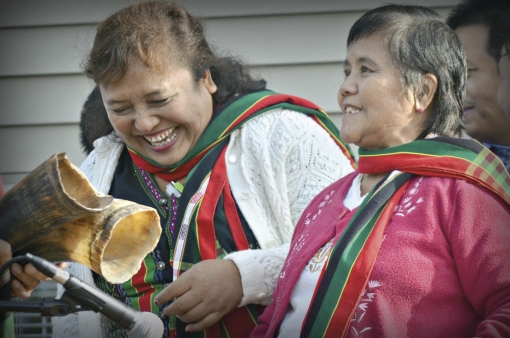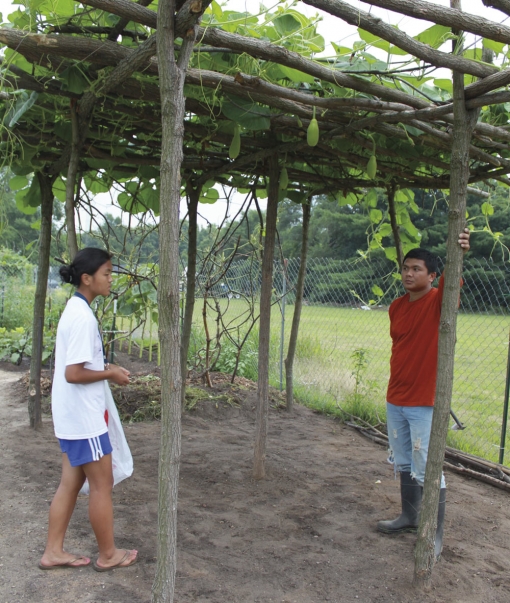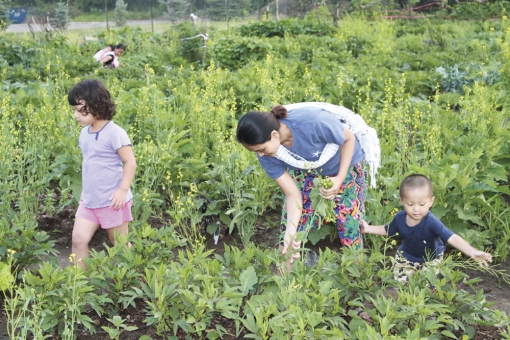Photos by Rita Kruk
In Battle Creek , MI, several hundred people are gathered to celebrate the grand opening of the Burma Center. Burmese women in the crowd are dressed in traditional floor-length wrap skirts, and men wear similar woven fabric draped and tied across one shoulder. Children run in and out while older women fry onion fritters to be set out alongside banana cakes, corn cakes, rice with peas and hot pepper sauce — all Burmese delicacies.
Edward Thawnghmung (THONG’-moong) strides to the stage and plays the cowboy classic “Red River Valley” on his harmonica, a favorite he learned as a child growing up in British-controlled Burma. He could hardly have known that six decades later, he would be performing it in the heart of America, to a room full of his own people.
Thawnghmung was determined to take his family out of Burma after a military coup toppled the fledgling democracy in 1962. Successive military regimes have perpetrated a string of human rights violations against the Burmese people, in particular the ethnic minorities such at the Shan, Karen, Rakhine, Chin and smaller groups that make up onethird of the population. Muslim and Christian minorities are also targets in the country, which is 89 percent Buddhist.
Battle Creek has developed as a hub for Burmese refugees, especially Christians, from the Chin region. The 2010 census reported 100,200 people of Burmese origin in the United States, including refugees, permanent residents and citizens, and that number has risen astronomically over the past decade, from only 631 Burmese refugee arrivals in 2000 to 16,901 in 2011. In Michigan, the annual number has grown from 16 to 639 in the same period.
The Thawnghmungs were the first Burmese to arrive in Battle Creek, after a local family agreed to sponsor them. More followed, from Burma or other parts of the United States. While Michigan is the only state to have seen its population decline over the past decade, refugees have helped repopulate both urban and rural areas of the state. In 2008, the US government raised the annual ceiling for refugee admissions from 70,000 to 80,000 in anticipation of a surge from Iraq, Iran and Bhutan. That year, Michigan doubled the number of refugees it admitted to nearly 4,000.
As an African American who came to this part of Michigan more than 20 years ago, I have watched these demographic changes with interest. The historic manufacturing town of Battle Creek has a population of just over 52,000 that is 71 percent white, 18 percent black, 6 percent Hispanic and 2 percent Asian. Stubborn patterns of residential and social segregation persist in the state, but it’s hard not to notice that the recent arrival of Asians from various countries has led to an increase in ethnic groceries, restaurants and informal catering businesses.
The intensively cultivated gardens in the Burmese community are completely different from the simple flatbed rows of those that characterize most neighborhood gardens. Burmese gardens are lush multilevel affairs with vines snaking along fences and climbing wooden poles to overhead lattices — leafy canopies that serve not only to support the growth of fruits and vegetables, but also as a shady resting spot on hot summer days. Their distinctive gardens have become wellknown in this area for their elaborate trellising and huge gourds hanging from vines. These gardens produce not just sustenance but other benefits as well: Some are trying to use the gardens as a way to teach good nutrition habits while others aim to bring what they have learned about food and agriculture back to their homeland.
Growing a Community
Edward’s daughter Martha, 40, and Jennifer Thuahzathang (THWAza- thang), 30, started the Burma Center this year to provide services to their community, everything from translation to English as a Second Language (ESL) classes and children’s playgroups. Martha has done this informally for many years, serving as an interpreter at doctors offices, businesses and parent-teacher conferences as well as running an ad hoc shuttle service.
The walls of the one-room center are lined with photos of soccer tournaments, ESL classes and outings, but one photo stands out. It shows an older man tending squash vines along a chain-link fence. “David Luai-Bik is our garden guru,” Martha says.
A professional agriculturalist, Luai-Bik has been advising and helping structure and cultivate the Burmese gardens after the community lobbied to grow their own food. Few were farmers in Burma, yet every household grew vegetables and herbs in kitchen gardens (that is, grown for home consumption rather than for commercial sale). Many newcomers find comfort in cultivating kitchen gardens because they miss familiar food and the practice of growing their own.
They are especially happy to have a place to grow two things that are essential in their cuisine: hibiscus leaves and small African eggplants. “The season is too short here in Michigan for the hibiscus plant to flower,” Martha says. “But it is the special taste of the leaves that is the key ingredient in our food. And the small eggplants are so flavorful that we cook them in sauces and even slice them to eat raw.”
For the Burmese, the gardens are not only a place to grow food but also a source of peace and solace, where they can speak their language and be with other Burmese. The first Burmese community garden started in 2008 was located near a public school. The last two gardens, established in 2010, are located near the farmers market and an apartment complex housing with many Burmese families. About 125 people cultivated the three gardens and the youth garden this year.
The broader Battle Creek community is taking notice. As in many towns across the country, Battle Creek has experienced a boom in community gardens and the movement to promote local foods. The Burmese community gardens are now participating in local food activities through the Good Food Battle Creek coalition, and last year, a local organization called the Fair Food Network awarded the Burmese community a $6,000 grant to strengthen the community’s gardening efforts and create a youth garden.
They Have Lost the Art
Martha’s brother Peter, a handsome 46-year-old with an easy smile, is the first in the family to graduate from college. He studied mechanical engineering at the University of Michigan and worked for the Kellogg Company in Battle Creek as a process engineer.
Battle Creek boasts an unusually high number of trained food scientists. Nutrition and good health have historically been a strong part of the city’s identity, beginning with the Kellogg brothers. The Kellogg Company was founded in Battle Creek in 1906 and was soon joined by two other cereal companies, Post and Ralston. But despite living in “Cereal City,” in the midst of these giants of the food industry, many Burmese American families in the area encourage their children to become doctors, nurses, engineers or accountants instead of pursuing a career in food science or agriculture.
The problem in Burma, Peter says, is a lack of trained food scientists. It is not a subject taught in universities there; Peter learned the process from watching YouTube. He is now focused on food business opportunities in that country, trying to build manufacturing companies for items that are typically imported but could be made domestically — with a little bit of his expertise.
For instance, take soy sauce: Currently, Burma grows soybeans and exports them to China or the Philippines to be re-imported as soy sauce. The same goes for with fish sauce: Traditionally made in Burmese homes, fish paste has become a product that foreign companies can mass produce for cheap. People in Burma say they have “lost the art” of making the paste. But Peter says it’s not an art, it’s a science and that Burmese people should be trained in it as the Chinese and Filipinos are.
Martha and Thuahzathang say they are heartened that a successful Burmese American immigrant like Peter is interested in helping and giving back. Given the still-rocky political climate, it has been difficult for Burma (called Myanmar by the current regime) to attract foreign investment. Many western countries, including the US, have imposed sanctions and banned new investments and imports to Burma because of the military regime’s ongoing human rights abuses and harassment of pro-democracy activists.
Now that the Burmese junta has taken a few small steps toward reform — with the 2010 release of pro-democracy leader Aung San Suu Kyi and hundreds of political prisoners in 2011 and in early 2012 — the timing may be ripe. At a January 2012 press conference, Secretary of State Hillary Clinton underscored plans to restore full diplomatic relations with the country for the first time in two decades. People like Peter, who are drawn by heritage to help with Burma’s development, may be the key to the country’s economic rebirth.
Building a Healthier Community
Thuahzathang and Martha want to encourage healthier practices in their community, especially cooking and gardening. Although she is fairly slender, Thuahzathang has been recently diagnosed with diabetes, and the prevalence of that disease and high cholesterol have been growing in the Burmese community here. “In Burma, we mostly boiled our food, and we only used a little bit of oil because it was expensive,” she says. “Here, everybody uses lots of oil because they can afford it and it tastes good. They will even add oil to sauces instead of water as they did in Burma.”
Martha’s other concern is the amount of synthetic fertilizer people put in their gardens. “They did not use fertilizer in Burma, but people see how fast things grow with it here and they just add more,” she says. Next year, Martha plans to organize a demonstration plot of organic gardening, where no fertilizers, pesticides or other chemical additives will be used.
Although food is important, language and jobs remain the biggest obstacles for newly arrived Burmese. Most find work at the local slaughterhouse. Counselors like Martha lament that these jobs make it harder for immigrants to learn English, a key step in their adjustment. “Working at the slaughterhouse is like being in jail,” Martha says. “It’s a death sentence.”
Through her years of providing informal support services to refugees, she has seen the importance of English for refugees, compelling her to make ESL the cornerstone of the new center’s offerings. English would smooth a lot of tasks, for example, understanding food safety regulations for Burmese who want to open catering companies or restaurants.
Here, the conversation returns once again to food: Martha and Peter complain that in America, it is difficult to find time to cook at home. “Why do you think food is so important in our culture?” Martha says.
“We cook together; everyone gets involved,” Peter says. He reminisces about helping his grandmother in the kitchen when he was a boy; this is how he learned to cook.
“As Burmese people, we don’t talk much about our feelings,” Martha says. “Maybe it’s our way of showing love.”
Cheryl Danley is a Food and Community Fellow with the Institute for Agriculture and Trade Policy and an outreach specialist with the Center for Regional Food Systems at Michigan State University.









Comments